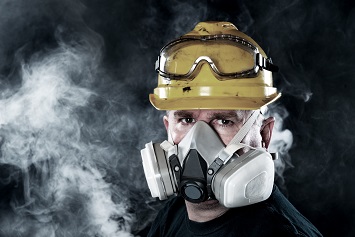Respiratory disease in workers resulting from exposure to occupational contaminants is a major area of research that was recently addressed by the National Occupational Research Agenda (NORA) in its draft National Occupational Research Agenda for Respiratory Health (Agenda).
According to NORA, the Agenda has a diverse audience, including occupational safety and health professionals; workers in all occupational groups; patients with diseases; employers; worker unions; and federal, state, and local health-related agencies. The public comment period on the draft Agenda closed July 13, 2018 (May 4, 2018, Federal Register (FR)).
The draft Agenda mainly consists of descriptions and discussions of the variety of the respiratory diseases resulting from occupational exposure to contaminants; how these diseases are transmitted; exposure-response relationships; documentation and dissemination of effective preventive interventions; and research needed to better understand causes, effects, and prevention. The National Institute for Occupational Safety and Health (NIOSH) will use the final Agenda to develop a NIOSH Strategic Plan.
The draft Agenda does not discuss OSHA’s respiratory protection standard at 29 CFR 1910.134, although it is conceivable that findings in the final Agenda will be used by OSHA to amend that standard.
Injury vs. Disease
The draft Agenda makes it clear that occupational respiratory illness is a complex issue. Generally speaking, physical occupational harm takes two forms—injury and illness. While the relationship between work and injury is usually clear, it can be far more difficult to say confidently that respiratory illness is caused by workplace conditions. For example, among all trades, construction workers have the highest percentage of cigarette smokers. But construction workers are also exposed to many occupational air contaminants. If a construction worker who smokes heavily contracts a serious respiratory illness, such as pulmonary fibrosis or asthma, how much—if any—of that disease can be attributed to working conditions?
Furthermore, most physical injuries are acute—that is, the result of on-site incidents. (Chronic injuries such as musculoskeletal disorders can occur over extended periods but can often be traced to prior occupational activity.) Respiratory diseases can incubate for years. If an individual becomes ill after leaving a job, it can be difficult to determine if the cause occurred before, during, or after employment.
Topics NORA believes require further attention as well as fresh research are summarized below.
Work-Related Respiratory Diseases
Among the respiratory diseases associated with occupational exposure, the draft Agenda highlights the following:
- Asthma tops the list of occupational respiratory illness. This disease consists of both occupational asthma caused by work and work-exacerbated asthma, or the worsening of existing asthma due to workplace conditions. An estimated 16.3 percent of adult-onset asthma cases are attributable to occupation, and the prevalence of work-exacerbated asthma is approximately 21.5 percent among adults with asthma. “Many asthma researchers are skeptical that asthma can be prevented, and additional studies are needed to confirm effectiveness of primary prevention efforts,” states NORA.
- Chronic obstructive pulmonary disease (COPD) is an inflammatory lung disease that impedes airflow and is a major cause of morbidity and mortality worldwide. In the United States, COPD was responsible for 137,693 deaths and 739,000 hospitalizations in 2008; in 2006, hospitalizations for acute exacerbations of COPD among persons 40 years and older were estimated to cost $11.9 billion dollars. While cigarette smoking is the primary risk factor for COPD, the American Thoracic Society estimates that 15 percent of the population burden of COPD can be attributed to occupational exposures.
- Pulmonary fibrosis is a form of chronic, progressive fibrosing interstitial pneumonia of unknown cause, occurring primarily in older adults. Known occupational exposures associated with development of pulmonary fibrosis include asbestos, inorganic dusts (coal mine dust, silica, and uranium dust), and certain metals.
- Millions of working and retired miners, as well as workers in other dusty trades, are at risk for a spectrum of lung diseases, including pneumoconioses. Beginning in 2000, X-rays of working U.S. coal miners showed an unexpected increase in the presence of pneumoconiosis. Among coal miners with this affliction, 35 percent showed rapidly progressive disease and 5 percent had severe progressive massive fibrosis that occurred mainly in underground Appalachian coal miners. Analysis of lung tissue samples in affected coal miners showed a preponderance of silica and silicate particulates, implicating exposure to respirable silica. In the United States, OSHA estimates 2.3 million workers are exposed to respirable crystalline silica in a variety of occupations, such as mining, stone and synthetic countertop cutting, sandblasting, and foundry work.
Healthcare Workers
Respiratory protective equipment can protect workers from inhalation of infectious agents associated with small particle aerosols and thus can potentially reduce the burden of occupationally acquired infectious diseases. But a variety of factors may limit effective use and compliance with recommended practices. These include user factors, such as comfort, ability to communicate, interference with work tasks, difficulty in breathing, skin irritation, and psychological factors. Users may also self-contaminate when doffing and fail to properly clean and decontaminate reusable respirators.
“To maintain a healthy, viable workforce, particularly in the event of emergency events like infectious disease epidemics and pandemics associated with risk for transmission via the aerosol route, focus must remain on improving the technology of respiratory protection to prevent infectious diseases and improve the way that protection is used,” states NORA.
NORA states that healthcare workers are highly susceptible to infectious diseases and influenza in particular. An evolving body of research shows that the influenza virus can remain suspended in the air in small particles for prolonged periods and potentially travel over long distances. While respiratory protection can effectively limit inhalation of such small airborne particles, most current hospital practices are based on limited epidemiology about occupationally acquired infections and the theory that influenza viruses are primarily transmitted by large droplets directly projected from infected individuals onto recipients’ mucous membranes or onto surfaces where they can subsequently be transmitted via indirect contact transmission.
“Given current uncertainties about the relative importance of various routes of transmission, it is not surprising that controversy remains as to the most appropriate strategies to protect healthcare workers from influenza,” states NORA. “Thus, focus must remain on documenting the relative importance of potential modes of transmission, the effectiveness of preventive interventions addressing potential modes of transmission including small particle aerosol transmission, and disseminating known effective interventions such as hand washing and influenza vaccination.”
Exposure
According to NORA, mixed occupational exposures—that is, exposure to multiple contaminants—can lead to a variety of adverse respiratory outcomes. One relatively recent example was provided by the World Trade Center-related investigations, which revealed a complex but poorly characterized mixture of toxicants (particulates, fibers, smoke, gases, fumes) that seems to have led to mixed respiratory health outcomes, such as a nonspecific chronic bronchitis, asthma, chronic bronchiolitis, and aggravated obstructive lung disease.
Respiratory disease from mixed exposures is also a growing concern for military personnel, defense department contractors, and U.S. government employees deployed in military operations. These workers are potentially exposed to multiple poorly characterized sources of lung injury during deployment, ranging from direct physical injury to the lung from explosive devices to airborne particulate exposures, including smoke from burn pits; desert dust; and dusts containing metals, such as cadmium, titanium, aluminum, and lead. Mounting evidence indicates that deployed military personnel have nearly twice the rate of respiratory symptoms compared to nondeployed personnel and that the incidence of respiratory symptoms increases with length of deployment.
NORA notes that traditional sources of data like the U.S. Bureau of Labor Statistics are much better at capturing data on work-related injuries than work-related illnesses. “Common respiratory diseases like asthma can have both occupational and non-occupational causes, and the occupational etiology is often not considered by treating clinicians and, consequently, not recognized and reported through surveillance systems,” states NORA. “Also, workplace exposures responsible for long latency diseases like chronic obstructive pulmonary disease could have occurred so far in the past that their work-relatedness is not recognized at the time of diagnosis and the disease is not labeled as related to work. Even if a long-latency disease is highly related to work, such as coal workers’ pneumoconiosis, if diagnosis occurs after a worker has left their industry/occupation, cases are not routinely counted in current surveillance systems until they pass away and the death information is reported.”
Measurement Technologies
Some of these assessment challenges are being met with improved measurement technologies, such as continuous personal dust monitors for coal miners and devices that can simultaneously measure a suite of different gases and dusts. But the accumulation of extensive information can also present problems.
“With a surge in real-time continuous exposure monitors, investigators are presented with the challenge of how to summarize thousands of data points for dozens of different agents,” says NORA.
The draft Agenda concludes by noting that a healthy workplace is the result of efforts by a variety of stakeholders:
“Communicating what is necessary to protect the respiratory health of workers requires shaping the message to facilitate understanding and motivate action by the target audience. This is an ongoing challenge in preventing occupational respiratory diseases, and should take advantage of technological and communication options that are constantly evolving.”



